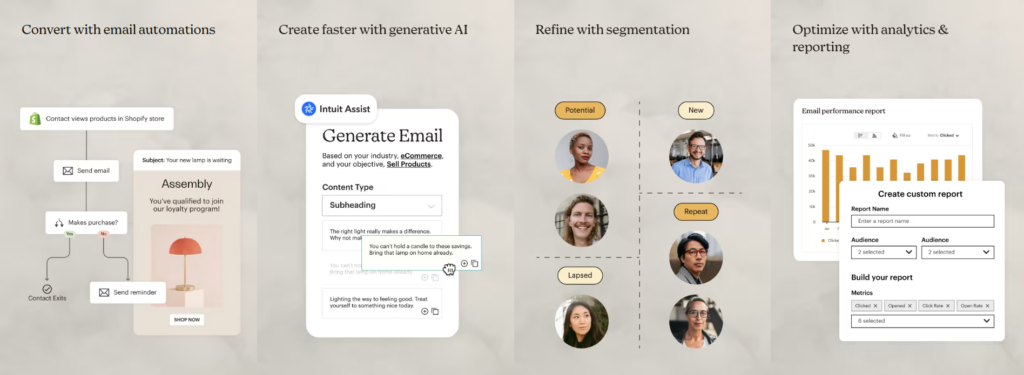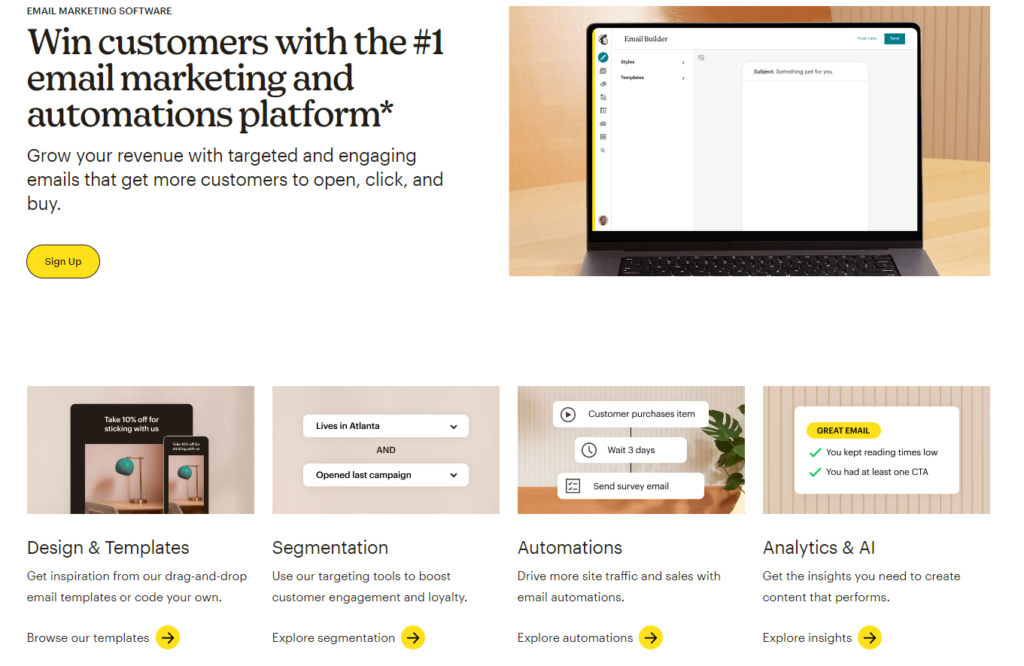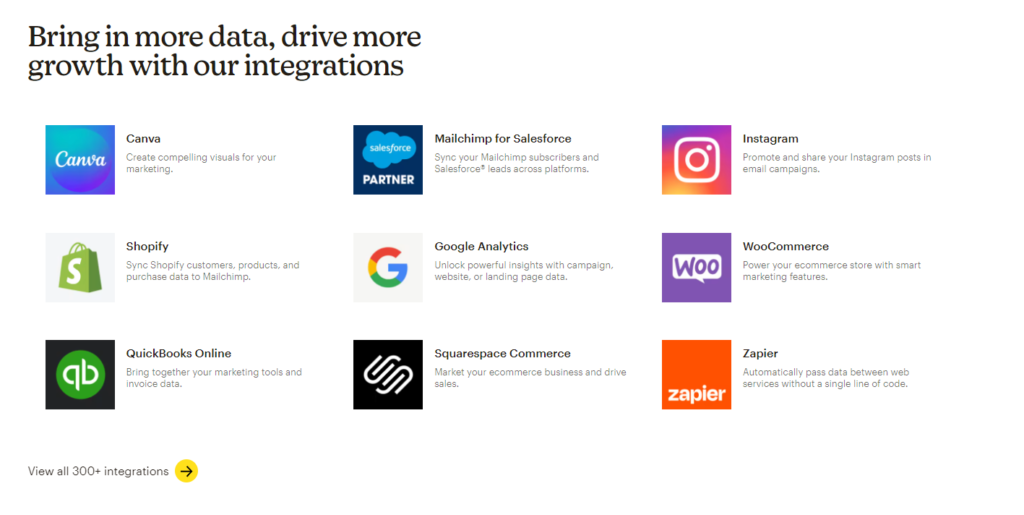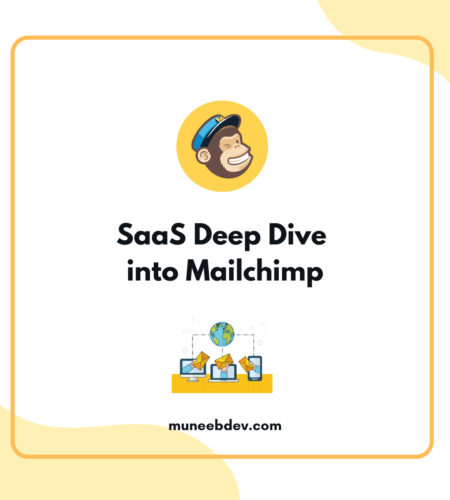Introduction
Mailchimp is a widely recognized email marketing and automation platform that has helped millions of businesses grow their audience, engage with their customers, and enhance their marketing efforts. Initially launched as a side project, Mailchimp evolved into one of the leading marketing platforms for small and medium-sized businesses, offering an intuitive interface, powerful analytics, and automation features. Today, it goes beyond just email marketing, providing an all-in-one marketing platform for businesses to handle customer engagement, e-commerce, and more.
In this deep dive, we’ll explore Mailchimp’s business model, key features, technological innovations, competitive standing, and its recent acquisition by Intuit.

1. Mailchimp’s Business Model: Freemium and Beyond
Mailchimp started with a freemium model, allowing users to send emails to up to 2,000 subscribers for free. Over time, it has expanded its offerings and introduced paid tiers that provide access to more features, higher volume email sending, and advanced analytics.
Key Revenue Sources:
- Subscription Plans:
- Free Plan: Includes basic email marketing features, up to 500 contacts, and 1,000 monthly email sends.
- Essentials Plan: Starts at $13 per month and offers more advanced features, including email templates, A/B testing, and multi-step journeys.
- Standard Plan: Costs around $20 per month and includes features like automation, behavioral targeting, and custom templates.
- Premium Plan: Starts at $350 per month, aimed at large enterprises with advanced segmentation, multivariate testing, and unlimited sends.
- E-commerce Integrations: Mailchimp partners with platforms like Shopify, WooCommerce, and BigCommerce, allowing users to run marketing campaigns directly from their stores.
- Additional Tools: Mailchimp has expanded beyond email marketing to include landing pages, social media ads, and CRM tools. Their “All-In-One Marketing Platform” adds additional revenue streams by integrating web design, automation, and content studio capabilities.
- Transactional Emails: With Mandrill, an add-on for Mailchimp, users can send targeted transactional emails like purchase confirmations and shipping notifications, earning Mailchimp additional revenue.
2. Key Features of Mailchimp: Beyond Email Marketing
Mailchimp’s offering has significantly grown beyond email marketing. Here’s a breakdown of its top features:
1. Email Marketing:
- Drag-and-Drop Editor: Allows users to create professional emails easily.
- Personalization: Advanced targeting based on behavior, purchase history, and custom criteria.
- A/B Testing: Enables users to test different subject lines, content, and designs to optimize their campaigns.

2. Marketing Automation:
- Customer Journeys: Automate tailored experiences based on customer behavior, such as abandoned cart emails, welcome series, and product recommendations.
- Triggers and Actions: Based on customer behavior, Mailchimp can trigger emails or other marketing actions automatically.
3. CRM (Customer Relationship Management):
- Users can manage and segment their audiences with advanced CRM features, allowing better targeting and customer management.
4. E-Commerce Tools:
- Shopify Integration: Mailchimp can sync with Shopify, helping store owners set up email automations for product recommendations, abandoned cart reminders, and retargeting campaigns.
- Pop-up Forms and Landing Pages: Create custom landing pages for products and services, adding another tool for conversion optimization.
5. Reporting and Analytics:
- Detailed Reports: Insights on click-through rates, open rates, and customer behavior.
- Engagement Monitoring: Allows businesses to track how their audience interacts with their emails and websites.
3. Integrations
Mailchimp’s integrations are one of its standout features, allowing users to connect the platform with various tools, making marketing and automation workflows seamless. Here’s a more detailed look at some of its key integrations with examples:

1. Shopify Integration
Use Case: E-commerce businesses can link their Shopify store with Mailchimp to automatically sync customer data, purchase history, and preferences. This allows businesses to segment their customers based on their shopping behaviors and send targeted email campaigns like abandoned cart reminders or product recommendations.
- Example: A Shopify store selling apparel can integrate Mailchimp to send out personalized emails to customers who left items in their shopping cart or to promote new arrivals based on their previous purchases.
2. Salesforce Integration
Use Case: Salesforce, a leading CRM platform, can be integrated with Mailchimp to streamline customer relationship management with email marketing efforts. It allows businesses to sync contact lists and automate email marketing campaigns based on customer data in Salesforce.
- Example: A real estate company using Salesforce can leverage Mailchimp to send targeted email campaigns to leads based on their property interests or follow up on recent inquiries.
3. Wix Integration
Use Case: Mailchimp integrates with Wix, a popular website builder, allowing users to capture leads and automatically add them to their Mailchimp email lists. Businesses can create signup forms on their Wix website, which seamlessly sync with Mailchimp to nurture leads through email marketing.
- Example: A small bakery using Wix to manage their website can integrate Mailchimp to automatically add customers who subscribe to their newsletter and send promotional emails about new products, deals, or events.
4. WooCommerce Integration
Use Case: For WooCommerce-powered online stores, Mailchimp allows businesses to track purchases and send post-purchase emails like thank-you notes, receipts, or follow-up requests for reviews. You can also set up automations for upselling or cross-selling.
- Example: A WooCommerce store selling electronics can use Mailchimp to send follow-up emails suggesting related products after a customer makes a purchase, increasing chances of repeat business.
5. Canva Integration
Use Case: Canva, a popular graphic design tool, integrates with Mailchimp to allow users to design visually stunning email templates directly in Canva and then export them to Mailchimp for use in email campaigns.
- Example: A marketing agency can create eye-catching newsletters using Canva’s templates and easily push these designs into Mailchimp to be used in client campaigns.
6. Zapier Integration
Use Case: Zapier acts as a middleman between Mailchimp and over 3,000 other apps, making it easy to automate workflows without needing coding skills. You can set up “zaps” to trigger actions in Mailchimp when events happen in other apps (e.g., adding a subscriber when a new row is added in Google Sheets).
- Example: A digital agency can use Zapier to integrate Mailchimp with Trello, automatically adding new email subscribers to a Trello card for easy team tracking.
7. WordPress Integration
Use Case: WordPress users can add Mailchimp signup forms to their websites, collect leads, and seamlessly build email campaigns using the customer data collected through their website forms.
- Example: A blogging platform can use this integration to grow their mailing list, sending automatic blog updates or promotional newsletters to their audience using Mailchimp.
8. Eventbrite Integration
Use Case: Event organizers can integrate Eventbrite with Mailchimp to sync attendee data and send automated email campaigns related to event updates, reminders, or follow-ups.
- Example: An event planner using Eventbrite for ticket sales can use Mailchimp to send personalized emails, like event reminders or post-event surveys to attendees.
9. Facebook Integration
Use Case: Mailchimp integrates with Facebook to allow businesses to run targeted Facebook ads directly from Mailchimp. Businesses can create lookalike audiences based on their email list, ensuring the ads reach a more relevant audience.
- Example: A fitness studio can create Facebook ads targeting customers who have interacted with their emails or signed up for their classes through Mailchimp.
10. Stripe Integration
Use Case: By integrating Mailchimp with Stripe, businesses can track revenue and customer behavior, allowing them to create email campaigns triggered by payments, like sending receipts, offering discounts, or following up after a sale.
- Example: A digital subscription service using Stripe for payment processing can automatically send a welcome email and upsell services after a successful payment using Mailchimp automations.
Why These Integrations Matter
Mailchimp’s integrations empower businesses to automate their workflows, improve personalization, and enhance customer experience. By connecting with these tools, businesses can streamline everything from lead collection and customer data management to email marketing and revenue tracking.
These integrations ensure that Mailchimp is not just a standalone email marketing tool but a hub that ties together various business functions, helping companies scale their marketing and communication efforts efficiently.
4. Mailchimp vs. Competitors
While Mailchimp is a leader in email marketing, it faces competition from platforms that also cater to SMBs and larger businesses. Let’s compare Mailchimp with some of its top competitors:
1. Constant Contact:
- Strength: Known for its customer support and event marketing features.
- Weakness: Pricing is higher, with fewer automation options than Mailchimp.
2. Klaviyo:
- Strength: Popular among e-commerce businesses for its advanced segmentation and integrations with Shopify and BigCommerce.
- Weakness: More expensive, with a steeper learning curve compared to Mailchimp’s beginner-friendly UI.
3. HubSpot:
- Strength: Offers an all-in-one CRM, marketing automation, and sales tool.
- Weakness: Expensive for small businesses compared to Mailchimp’s more affordable tiers.
4. GetResponse:
- Strength: Offers webinar hosting and landing pages in addition to email marketing.
- Weakness: Its user interface is less intuitive than Mailchimp’s, and it lacks a strong app ecosystem.
5. Why Businesses Choose Mailchimp
Businesses across various industries choose Mailchimp for several compelling reasons, supported by data and logical benefits that make it one of the leading email marketing platforms worldwide. Here’s an in-depth explanation of why businesses prefer Mailchimp:
1. Ease of Use
One of the key reasons businesses opt for Mailchimp is its user-friendly interface. With intuitive design, Mailchimp allows even those without a background in digital marketing to create and send professional-looking email campaigns. Businesses can quickly onboard new users and start sending campaigns without extensive training.
- Data: According to Capterra reviews, Mailchimp’s ease-of-use rating stands at 4.5 out of 5, making it accessible for businesses of all sizes, from startups to large enterprises.
2. Affordable Pricing Plans
Mailchimp operates on a freemium model, making it highly appealing to small and medium-sized businesses. It offers a free tier that allows businesses to send up to 10,000 emails per month to a maximum of 2,000 subscribers. For companies just starting with email marketing, this is an attractive option as they can test the waters without a financial commitment.
- Data: A survey conducted by GetApp revealed that over 85% of small businesses using Mailchimp benefit from the free plan before scaling up to paid tiers as they grow.
3. Comprehensive Features for Growing Businesses
Mailchimp is more than just an email marketing platform; it provides a comprehensive marketing toolkit. As businesses grow, Mailchimp offers advanced features such as marketing automation, segmentation, A/B testing, and analytics, helping businesses scale their marketing efforts efficiently.
- Automation: Automated workflows allow businesses to nurture leads, send abandoned cart emails, or onboard customers with welcome series—all without manual intervention.
- Data: Mailchimp claims that businesses using its automation features experience up to 16 times more orders compared to those who do not use automation Integration with Popular Tools Mailchimp integrates seamlessly with over 300 third-party applications like Shopify, Salesforce, Facebook, Google Analytics, WooCommerce, and more. These integrations make it easy for businesses to connect their email marketing with e-commerce platforms, CRM systems, and social media channels, streamlining workflows and enabling deeper customer insights.
- Use Case: For e-commerce businesses, Mailchimp’s integration with Shopify is invaluable. It allows businesses to track purchases, segment customers, and send personalized emails based on buying behavior, significantly improving customer engagement.
- Data: Mailchimp’s integration with Facebook ads shows that users saw an average return on investment (ROI) of up to 29%, thanks to its ability to target email subscribers and similar audiences directly through Facebook ads .
AI-Driven Insights and Personalization
Mailchimp has made significant advancements in AI-powered tools that help businesses automate tasks and personalize their communications. For instance, Mailchimp’s Smart Recommendations feature uses predictive insights to suggest products, timing, and messaging that resonate most with customers.
- Data: According to Mailchimp’s internal research, businesses using its AI-driven recommendations and personalization features have seen up to 30% higher open rates compared to those who don’t utilize them.
- Example: Generative AI for email content creation helps businesses craft more engaging subject lines, calls to action (CTA), and email body copy, reducing the time spent on content creation while ensuring more impactful messages.
6. Data and Reporting Tools
Mailchimp offers robust analytics and reporting features, allowing businesses to track open rates, click-through rates, and conversion rates with ease. The platform also provides customized reports and recommendations based on user data, making it easier to adjust and improve campaign performance.
- Data: Users have reported an average open rate of 22.71% and a click-through rate of 2.91%, slightly above the industry average, highlighting Mailchimp’s effectiveness in driving user engagement .
7. Scala Businesses of All Sizes
Mailchimp is scalable, allowing businesses to start small and grow over time. Whether you’re a startup looking for basic email campaigns or a large enterprise needing advanced segmentation and automation, Mailchimp’s tiered pricing plans offer a solution for every stage of growth.
- Growth Stats: As businesses scale, they can move from Mailchimp’s free tier to Essentials, Standard, or Premium plans, which offer more advanced features. Companies that have scaled their marketing efforts with Mailchimp report up to 44% growth in engagement by upgrading to higher-tier plans that offer better segmentation and analytics .
8. Proven Track RTrusted by Millions
Mailchimp is a trusted name in email marketing, with over 11 million users globally. It has helped businesses generate up to 25x ROI with its marketing campaigns, according to Mailchimp’s own metrics. This wide user base provides confidence to new users who want a reliable and proven solution.
- Global Reach: Mailchimp’s users span across over 175 countries, and businesses in various industries—from retail to non-profits—have benefited from its robust suite of tools.
9. Reliable Customer Support and Learning Resources
Mailchimp offers a comprehensive support system that includes live chat, email support, and an extensive knowledge base. For new users, Mailchimp also offers tutorials, webinars, and case studies that provide valuable insights into optimizing email marketing strategies.
- Data: Businesses report 92% satisfaction with Mailchimp’s customer support, particularly for small business owners who rely heavily on timely assistance .
6. Financial Growth and Acquisition by Intuit
In September 2021, Intuit acquired Mailchimp for $12 billion, marking one of the most significant acquisitions in the marketing technology space. Intuit’s portfolio includes major software brands like QuickBooks, TurboTax, and Mint. By acquiring Mailchimp, Intuit aims to create an all-in-one platform for small businesses, combining financial software with marketing solutions.
Key Points:
- Integration with QuickBooks: Mailchimp users can now seamlessly manage their finances and marketing in one place.
- Valuation: Mailchimp’s growth and popularity made it one of the largest privately held marketing platforms before its acquisition.
- Revenue: Mailchimp generated over $800 million in annual revenue in 2020, serving more than 12 million businesses globally.
Conclusion and CTA
Mailchimp remains a key player in the email marketing and marketing automation sector, with its robust platform supporting businesses of all sizes. Its freemium model, combined with the introduction of advanced paid features, has helped millions of businesses grow their online presence. With the added resources and expertise from Intuit, Mailchimp is well-positioned for continued innovation and expansion.
Looking to boost your email marketing efforts? Try Mailchimp today and discover how their powerful tools can help you reach your audience, automate your workflows, and increase sales.


Comments